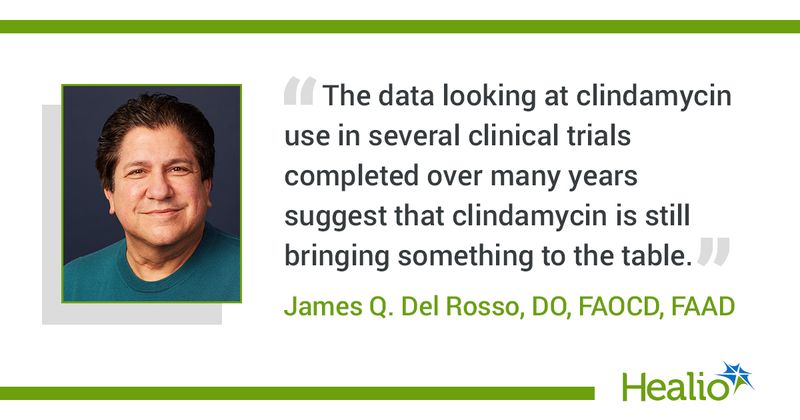Clindamycin continues to play safe, relevant role in acne treatment
Key takeaways:
- Clindamycin is not recommended as a monotherapy but contributes to efficacy for acne when used in combinations.
- James Q. Del Rosso, DO, FAOCD, FAAD, discussed the concerns, applications surrounding clindamycin.
Clindamycin remains clinically relevant and safe in the treatment of acne vulgaris, according to a comprehensive published review.
“Clindamycin is a drug that has been around for many years,” James Q. Del Rosso, DO, FAOCD, FAAD, research director and principal investigator at JDR Dermatology Research, told Healio. “It is not a new chemical entity and has been used as an approved systemic antibiotic for the treatment of a wide variety of susceptible bacterial infections in several disciplines of medicine not necessarily related to dermatology. However, over time, it was shown to be effective topically for the treatment of acne, for which it eventually became FDA-approved in a variety of vehicle formulations.”

According to this review led by Del Rosso, which details the benefits and risks of clindamycin, both topical and oral formulations of the drug are available for use in the treatment of acne, although oral clindamycin is not FDA-approved for acne treatment. Among dermatologists, topical therapy is the primary agent used with combination therapy formulations being favored to optimize efficacy and reduce the potential for antibiotic resistance.
“It has had a long lifespan,” Del Rosso added, “but it is holding its own.”
As an antibiotic, topical clindamycin is both antibacterial and anti-inflammatory in nature. Its effects on the skin may be antimicrobial in nature by inhibiting Cutibacterium acnes proliferation and by the potential for anti-inflammatory effects that are unrelated to antibiotic activity.
The most recent recognition of the benefits of clindamycin occurred in October 2023 when the FDA approved the first triple-combination gel, comprised of clindamycin phosphate 1.2%, adapalene 0.15% and benzoyl peroxide 3.1%, for the treatment of acne.
However, many clinicians still feel stuck on the potential drawbacks associated with use of clindamycin, which are primarily an issue when clindamycin is used as a monotherapy, which is not recommended.
A major concern for both patients and physicians is the long-standing potential for antibiotic resistance.
According to Del Rosso, clindamycin as a monotherapy can cause antibiotic resistance and should not be used alone. But when combined with other ingredients, primarily benzoyl peroxide, which is included in the triple-combination formula, antibiotic resistance is significantly reduced. Studies have shown that the fixed-dose triple-combination with clindamycin has a very favorable safety and tolerability profile with no consistent systemic safety signals emerging
Some may contest that when combined with other ingredients, clindamycin does not contribute to the positive outcomes seen in combination topical acne treatment. However, Del Rosso explains that this is not true based on a large body of data collected over several years.
“The data looking at clindamycin use in several clinical trials completed over many years suggest that clindamycin is still bringing something to the table,” Del Rosso told Healio. “So, I certainly believed, based on the evidence, that it is doing something.”
According to the review, studies that compared the triple combination formula with dyad formulas that did and did not contain clindamycin showed that the triple combination formula was superior, indicating that the combination of all three ingredients is important for the treatment of acne.
While Del Rosso emphasized that the safety risks of clindamycin are small and the threat of antibiotic resistance has been mitigated by combination formulas, patients may still be wary when taking this medication based on the few adverse reports that are published, especially several years ago.
So, how can dermatologists help a hesitant patient?
“Education,” Del Rosso said. “If people are not going to want to do something because there is a low-risk warning, then I suggest they do not drive their car, right? Every time they get in a car there is a potential risk of death or serious injury, though people agree to take that risk without even thinking about it. There are many things listed as warnings in package inserts that we have to deal with on a daily basis... so you have to put into perspective the likelihood of something actually happening versus the potential for improvement in their acne.”
